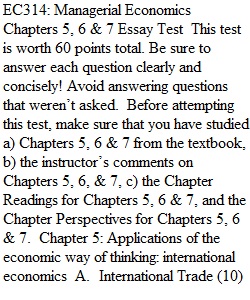


Q EC314: Managerial Economics Chapters 5, 6 & 7 Essay Test This test is worth 60 points total. Be sure to answer each question clearly and concisely! Avoid answering questions that weren’t asked. Before attempting this test, make sure that you have studied a) Chapters 5, 6 & 7 from the textbook, b) the instructor’s comments on Chapters 5, 6, & 7, c) the Chapter Readings for Chapters 5, 6 & 7, and the Chapter Perspectives for Chapters 5, 6 & 7. Chapter 5: Applications of the economic way of thinking: international economics A. International Trade (10) Economists are nearly unanimous in their support of free trade yet governments often use tariffs and quotas to interfere with free trade. According to the textbook, what explains the difference? Who is correct, the economists or the government, and why? B. International Finance (10) 1. What does it mean for the U.S. dollar to be “strong” or “weak”? 2. Who gains and who loses from a weak or a strong dollar and why? Is it better for a country to have a weak or a strong dollar? Chapter 6: Applications of the economic way of thinking: environmental economics A. Environmental Economics (10) Nobody likes pollution (or crime, or accidents)! But economists, as they so often do, bring a different perspective to the issue of pollution. Assume that a paper plant dumps the chemicals it uses in making paper into the river it is located next to, polluting the river for downstream users. The paper plant operates in a perfectly competitive market (the price it charges for its products equals its average total cost of production, not counting the costs of pollution, and it earns only a normal profit on its business.) 1. Who loses and who gains from the pollution caused by this plant? (5) 2. Explain why the economist says that it doesn’t make sense to reduce the amount of pollution to zero. What is the “optimal” amount of pollution? (5) B. Quicksilver Capital (10points) The authors, in the textbook and in the online readings for Chapter 6, present both the potential advantages and the potential disadvantages of increased capital mobility. These arguments are relevant from both a domestic (companies shopping for subsidies and tax breaks from governments as a condition for relocating) and international (outsourcing of productive activities and relocating headquarters to another country) point of view. Based on what you have read, do you think that this increasing mobility of capital will, on net, be a good or a bad thing for the competitiveness of business and of government? Be sure to tie your answer to the points made in the textbook and the readings. ? Chapter 7: Consumer choice and demand in traditional and network markets A. The law of demand says that when the price of something goes down people buy less of it (and vice versa), all other things being equal. Such a change is referred to as an increase in quantity demanded and is shown by a movement down along a given demand curve. By contrast, an increase in demand is shown by a rightward shift in the entire demand curve. 1. Some people seem to believe that there are goods for which the law of demand is irrelevant, goods that people just “can’t do without.” Why do economists believe that the law of demand applies to all goods. (4) 2. Explain what would have to happen to each of the following in order for the demand for widgets to go up: a. Consumer incomes (2) b. Prices of other goods (2) 3. You hire a consultant to estimate the elasticity of demand for widgets, the product that your company produces and sells. When you receive the report, it indicates that the elasticity of demand for widgets is -0.6. Briefly explain what that means and how it would affect your firm’s pricing decision? (4) B. For “standard” goods, the consumption of a good today has no effect on future consumption. But, the authors suggest that this is not true of all goods. 1. Briefly explain the distinction between a “lagged-demand” and a “network” good, giving examples of each. (4) 2. If the widgets are a “network” good, how would it affect your firm’s pricing strategy. (4)
View Related Questions